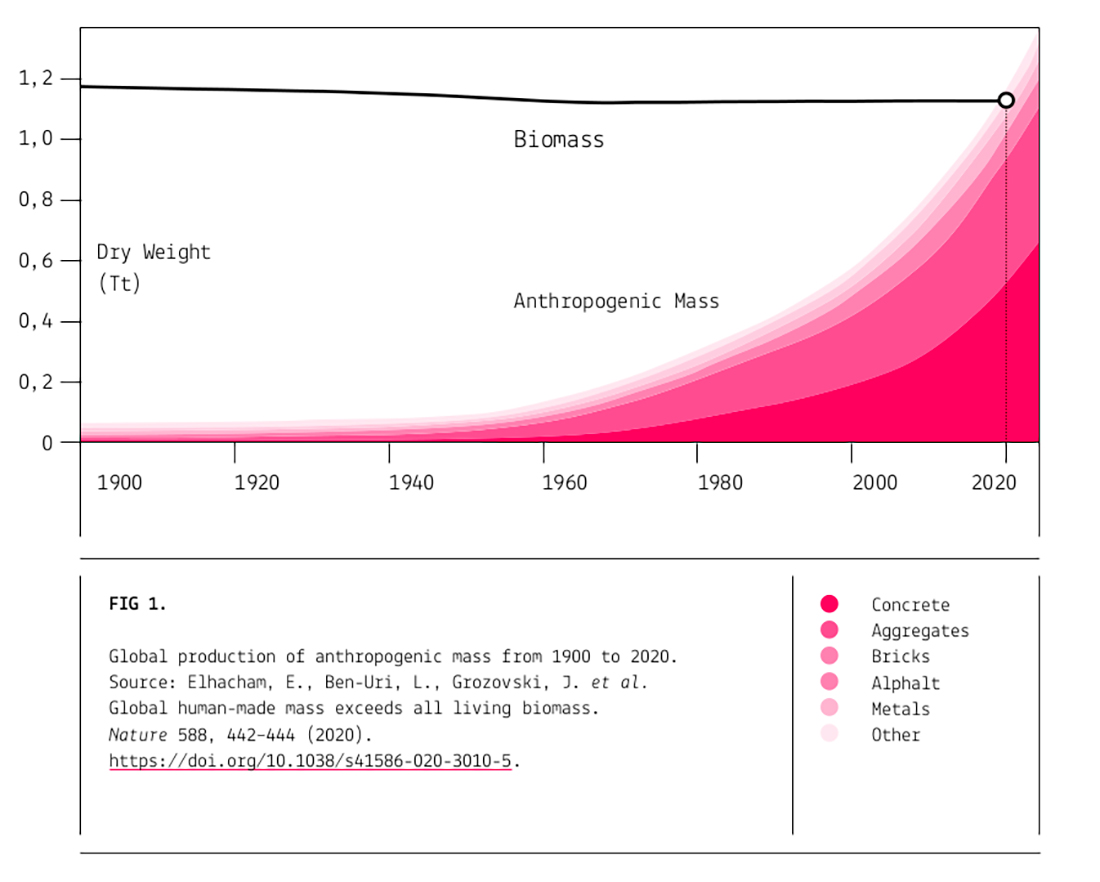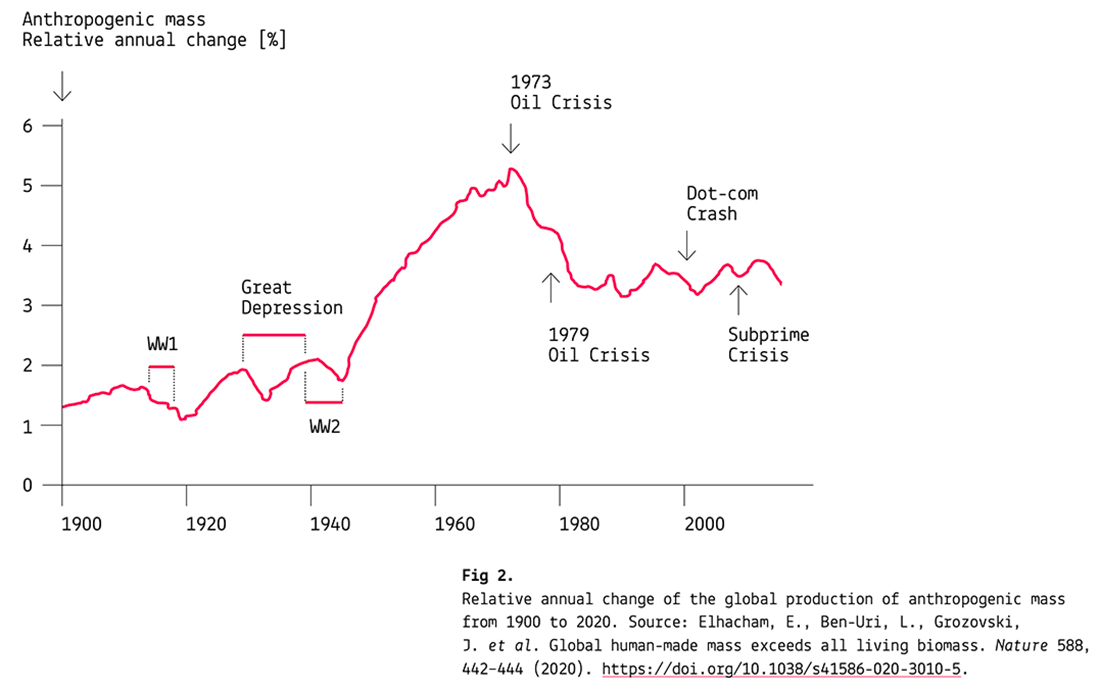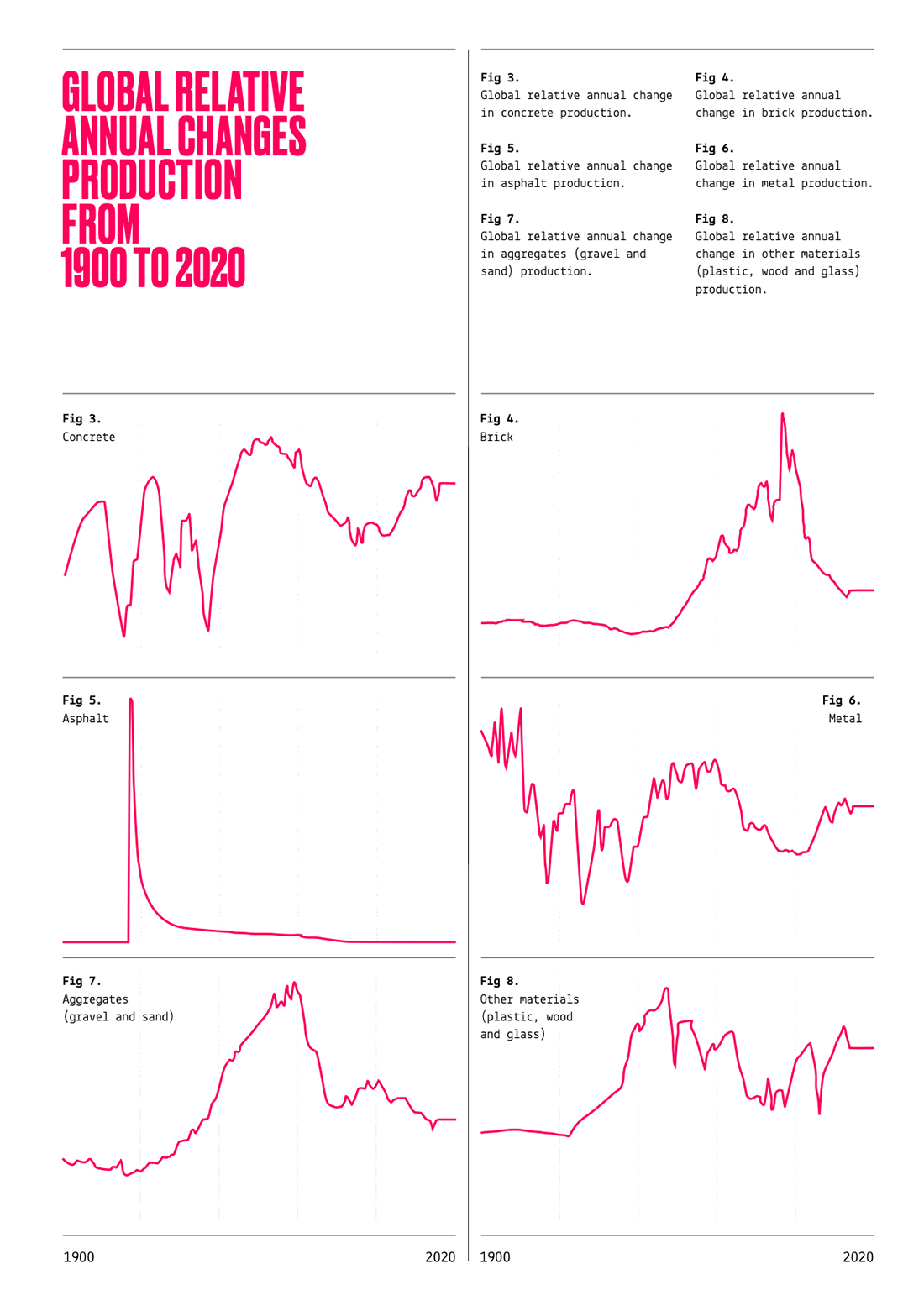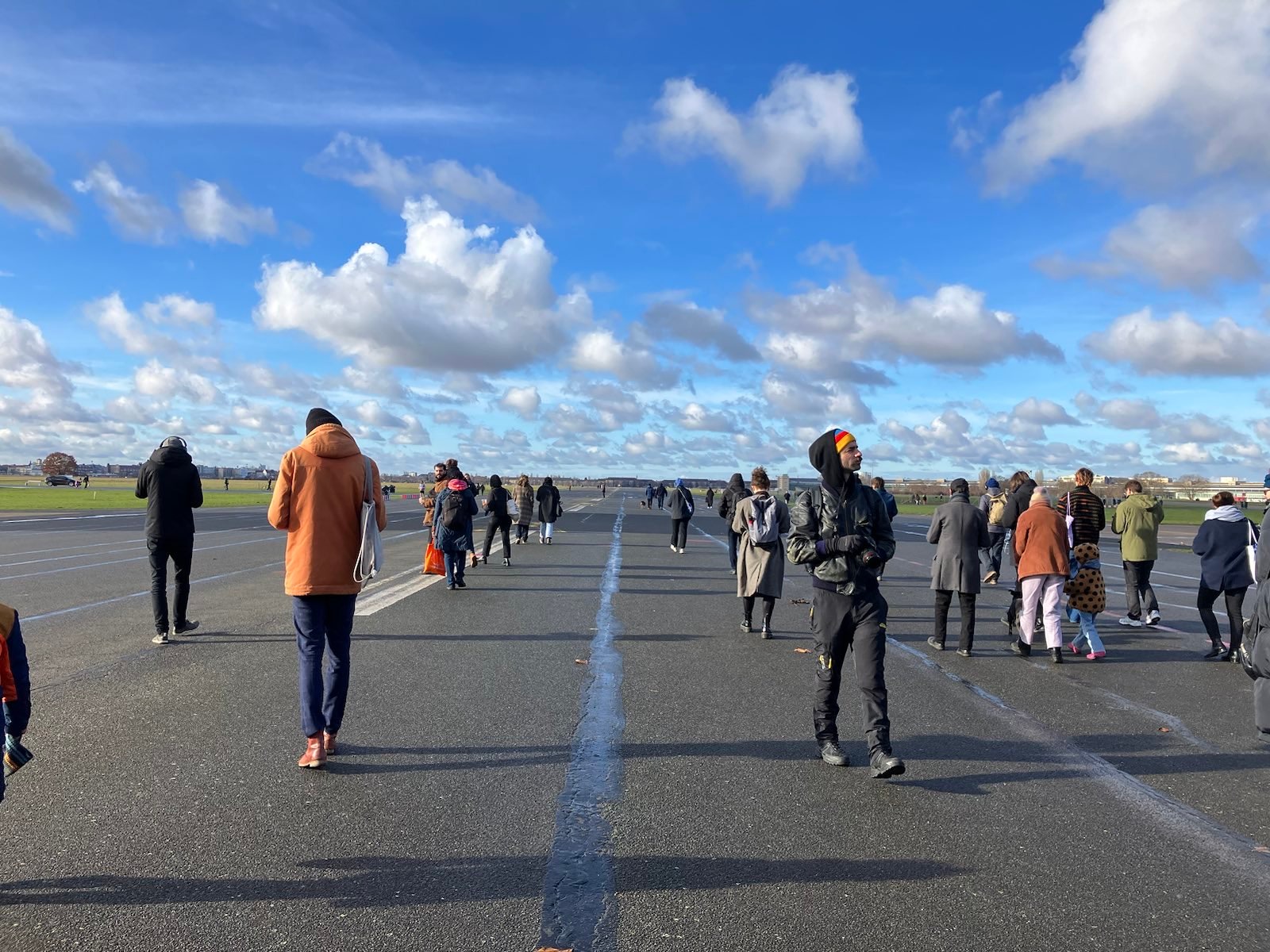Anthropogenic mass
Joana Moll
Related terms: amnesia, biomass, climate embodiment, materialism, techno-capitalism
A recent study performed at the Weizmann Institute of Science has determined that in the year 2020, the collective weight of the objects built by humans exceeded that of the total biomass of our planet. Biomass refers to the mass of living organisms, including plants, animals, and microorganisms, or, from a biochemical perspective, cellulose, lignin, sugars, fats, and proteins. The estimate calculated by the study indicates that everything that humans have created, maintained, or discarded (anthropogenic mass) weighs more than all the living things on earth combined (biomass). In a few words, this imbalance, in a process of constant acceleration, is radically eroding the biosphere’s ability to regenerate itself.
 “A Silent Opera for Anthropogenic Mass” focuses on exploring the insidious, yet silent production of anthropogenic mass. It is precisely the silent quality of this process (from a human perspective) that makes it particularly critical, as it blinds us to consciously experience and identify the different realities left by this subtle, yet brutal, transformation of our natural ecosystems, making it increasingly difficult to re-imagine relationships and future paradigms consistent with our contemporary climatic, technological, and human conditions. Moreover, a form of collective amnesia named the Shifting Baseline Syndrome (SBS) is progressively challenging any shared initiative of restoring our relationship with nature. SBS is based on ‘a gradual change in the accepted norms for the conditions of a natural environment due to a lack of experience, memory, and/or knowledge of its past condition’. In other words, what a generation experiences as normal can be radically different when another generation appears, and subsequently apprehends this emerging reality as normal. Thus, developing rituals aimed at experiencing the increasing cannibalization of ecologies, exemplified by the persistent increase of anthropogenic mass, is an urgent exercise.
“A Silent Opera for Anthropogenic Mass” focuses on exploring the insidious, yet silent production of anthropogenic mass. It is precisely the silent quality of this process (from a human perspective) that makes it particularly critical, as it blinds us to consciously experience and identify the different realities left by this subtle, yet brutal, transformation of our natural ecosystems, making it increasingly difficult to re-imagine relationships and future paradigms consistent with our contemporary climatic, technological, and human conditions. Moreover, a form of collective amnesia named the Shifting Baseline Syndrome (SBS) is progressively challenging any shared initiative of restoring our relationship with nature. SBS is based on ‘a gradual change in the accepted norms for the conditions of a natural environment due to a lack of experience, memory, and/or knowledge of its past condition’. In other words, what a generation experiences as normal can be radically different when another generation appears, and subsequently apprehends this emerging reality as normal. Thus, developing rituals aimed at experiencing the increasing cannibalization of ecologies, exemplified by the persistent increase of anthropogenic mass, is an urgent exercise.
 In the shape of a sound art and media installation, “A Silent Opera for Anthropogenic Mass” intends to perform the quiet metamorphosis of our life-giving habitats into anthropogenic mass. Ultimately, this project aims to highlight the subtle but continuous replacement of the natural order by technological progress, and reflect not only on the destruction of ecosystems but also on the difficulty of making climate change visible. The opera can be heard on the Tempelhofer Feld in Berlin through a web app. You will need a mobile device with a data connection and some headphones. The graphs accompanying the audio walk are included in the opera’s “libretto” in the same consecutive or chronological way as they unfold on one’s mobile device during the walk:
In the shape of a sound art and media installation, “A Silent Opera for Anthropogenic Mass” intends to perform the quiet metamorphosis of our life-giving habitats into anthropogenic mass. Ultimately, this project aims to highlight the subtle but continuous replacement of the natural order by technological progress, and reflect not only on the destruction of ecosystems but also on the difficulty of making climate change visible. The opera can be heard on the Tempelhofer Feld in Berlin through a web app. You will need a mobile device with a data connection and some headphones. The graphs accompanying the audio walk are included in the opera’s “libretto” in the same consecutive or chronological way as they unfold on one’s mobile device during the walk:
Download the opera’s libretto here
What are you going to hear?
“A Silent Opera for Anthropogenic Mass” stages the global production of anthropogenic mass from 1900 to 2020 through a web app, using text, sound, and space. Anthropogenic mass is defined as ‘the mass embedded in solid inanimate human-made objects that have not yet been demolished or decommissioned’ and is composed of six different groups of materials: concrete, bricks, asphalt, metals, aggregates (gravel and sand), and other materials (plastic, wood, and glass). Since 1900, the global amount of anthropogenic mass has increased steadily (Fig. 1); however, the annual global production of this mass has been directly affected by global events (as shown in Fig. 2) and thus experienced substantial production rate changes in the last 122 years. This opera sonifies the yearly fluctuations in the production rate of the six groups that compose anthropogenic mass (Fig. 3 to 8), along with the global accumulation of anthropogenic mass (Fig. 1) from 1900 to 2020.
What are you going to see?
The audio composition played by the web app is supported with text for contextualization purposes. The web app interface shows the year that corresponds to the sound currently playing and a headline of a historical event that happened in that very same year. The web app also displays the global amount of concrete, bricks, asphalt, metals, aggregates, and other materials produced during that year, together with the annual accumulation of anthropogenic mass. The web app interface allows the activation and deactivation of the seven audio channels that create the composition of the opera for a personalized listening experience.
 How does it work?
How does it work?
The opera is activated by walking through a specific space, and it is located in one of the main airstrips of Tempelhofer Feld in Berlin. The starting point stages the overall anthropogenic mass produced in 1900, while the ending point represents the global accumulation of such mass in 2020. This setup allows the audience to experience the opera not only forwards but also backwards: from 1900 to 2020, and from 2020 to 1900.

Reference
Elhacham, Emily, Liad Ben-Uri, Jonathan Grozovski et al. 2020. “Global human-made mass exceeds all living biomass” Nature 588: 442–444.
